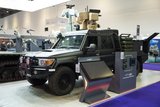Hensoldt details Spexer radar orders
Hensoldt has received orders worth around $43 million for the Spexer 2000 ground surveillance radar from unnamed customers in the Middle East and North Africa region since the beginning of 2017, the company announced on 4 May.
The Spexer 2000 radar is designed for border and coastal surveillance, the protection of critical infrastructure, and battlefield surveillance. The radar has high doppler and velocity resolution and strong clutter suppression, enabling the reliable detection, tracking and classification of even small and slowly moving targets such as pedestrians; as well as fast objects such as guided missiles.
A camera mounted on top of the radar can be added to identify suspicious objects, ensuring a high level of situational awareness to provide border guards and security forces with additional reaction time.
The 2017 orders total around 50 units.
Thomas Müller, CEO of Hensoldt, said: 'Spexer 2000 is based on the latest active electronically scanned array technology with electronic beam scanning. This means that several operating modes or radar missions are possible at the same time, dramatically increasing the radar's detection capabilities. As a result, one Spexer radar can replace several conventional radar systems.'
Related Equipment in Defence Insight
More from Digital Battlespace
-
![Babcock nears first customer for Nomad AI translation tool]()
Babcock nears first customer for Nomad AI translation tool
Nomad can provide militaries with real-time intelligence, saving critical time on the battlefield.
-
![AUSA 2025: Israel’s Asio Technologies to supply hundreds of improved Taurus tactical systems]()
AUSA 2025: Israel’s Asio Technologies to supply hundreds of improved Taurus tactical systems
Taurus operates alongside the Israel Defense Forces’ Orion system which supports mission management across tens of thousands of manoeuvring forces, from squad leaders to battalion commanders.
-
![AUSA 2025: Kopin pushes micro-LED plans as China moves faster]()
AUSA 2025: Kopin pushes micro-LED plans as China moves faster
The plan for the new displays follows fresh investment in Kopin’s European facilities by Theon and an order for head-up displays in fielded aircraft, with funding from the US Department of Defense.
-
![AUSA 2025: Persistent Systems to complete its largest order by year’s end]()
AUSA 2025: Persistent Systems to complete its largest order by year’s end
Persistent Systems received its largest ever single order for its MPU5 devices and other systems earlier this month and has already delivered the 50 units to the US Army’s 4th Infantry Division.
-
![Aselsan brings in dozens of companies and systems under the Steel Dome umbrella]()
Aselsan brings in dozens of companies and systems under the Steel Dome umbrella
Turkey has joined the family of countries attempting to establish a multilayered air defence system with government approval in August 2024 for the effort landed by Aselsan. Dubbed Steel Dome, the programme joins Israel’s Iron Dome, the US Golden Dome, India’s Mission Sudarshan Chakra and South Korea’s low-altitude missile defence system.
-
![DSEI 2025: MARSS unveils new agnostic multidomain C4 system]()
DSEI 2025: MARSS unveils new agnostic multidomain C4 system
MARSS’ NiDAR system has been deployed using sensors from static platforms to provide detection and protection for static sights, such as critical infrastructure, ports and military bases.




























